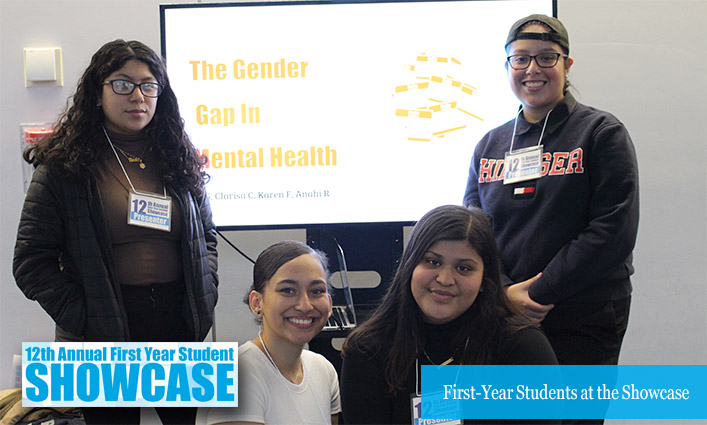
With topics ranging from reproductive rights to the death penalty, foot binding to Latinx students in higher education, the 12th Annual First Year Student Showcase, held on December 11, highlighted the innovative research investigated by our freshman class. For the student presenters—many of whom came from APPLE Corps, ACE, ¡Adelante!, Early Start, ISP, LEAP, and SEEK—this showcase provided them with a first-time experience conducting research, presenting in front of a large group of people, and using their voice to be fierce advocates for justice. With 197 research groups, 10 disciplines represented, and 818 first-year students, this was the largest First Year Student Showcase the College has ever seen.

“Today, you’ve reached an important milestone in your academic career here at John Jay,” said President Karol V. Mason as she congratulated the student presenters and thanked the 25 faculty members who supported the students. “You’ve not only spent time researching a justice-focused issue with your fellow students, but you’re experiencing what it’s like to present those findings to a larger community. These are critical skills for your future career, graduate school, and every aspect of your life going forward. Thank you for being a part of this incredible display of hard work, collaboration, and research.” Eager to share their projects with the John Jay community, we spoke to several student presenters to learn more about their research and how it relates to the College’s mission of exploring justice in all its many dimensions.

Angeline McGovern ’23, Juliana Delgado ’23, and Ryan Laureano ’23
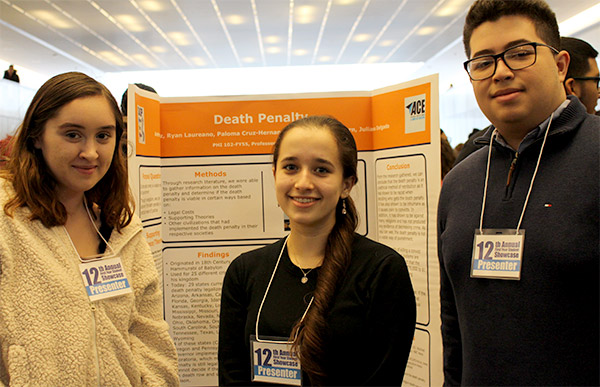
“Since we are a College focused on justice, we can’t allow for laws and policies to make any group of our population feel inferior.” —Juliana Delgado
Delgado: For our project, we covered the death penalty. In covering this topic, we focused on the factors that support how the death penalty is cruel and unusual and how it should be abolished throughout our country. What we found was that the death penalty is racist toward minorities and has been used as punishment in crimes committed by members of underrepresented populations. If we look at various parts of our history, where the death penalty was the main source of punishment, it’s clear that it was not effective and it didn’t deter crime. Since we are a College focused on justice, we can’t allow for laws and policies to make any group of our population feel inferior. If we continue to encourage and allow this racism and judgement to happen in our legal system, through things like the death penalty, we are never going to have a fair and just society.
Katia Vazquez ’23, Arlin Sanz ’23, and Janibel Adan ’23
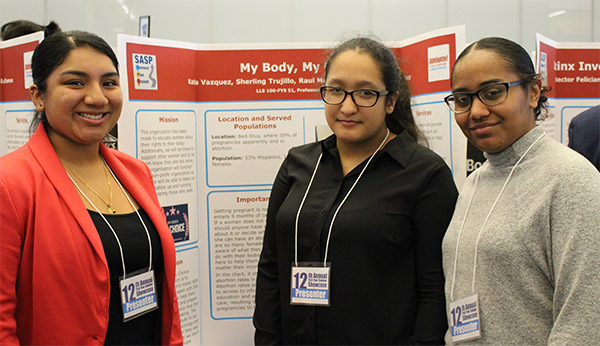
Vazquez: The title of our project is “My Body, My Choice.” We created this organization to help women of all ethnicities—but especially Latinx women—so that they are aware of their rights. In this organization, one of the main topics that we cover is abortion, because it is a very important topic at the moment. A lot of people believe that they have the authority to tell women what they can and cannot do with their bodies, but through this organization, we want women to know that they have the right to do whatever they want with their bodies and that if they want to get an abortion, it is their right to do so. Empowering women and informing them about their reproductive rights is incredibly important to us. We know that a lot of states have policies against abortions, which goes against allowing women the right to choose, but we would like to change that. We encourage women to stand together and speak up against policies that hinder a women’s voice. That to us is fighting for justice.
Manuel Peralta ’23 and Lara Choudhury ’23
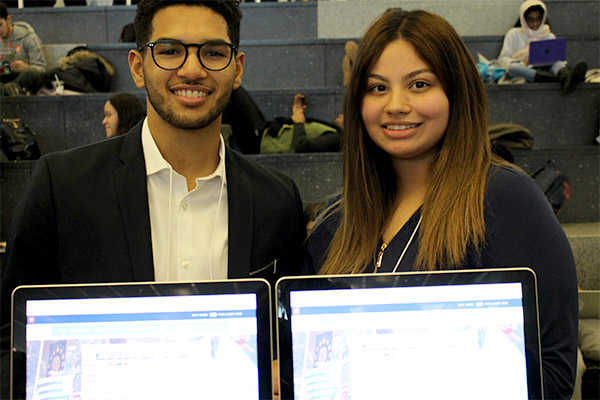
Choudhury: Our project is about Latinx individuals and the inclusion struggles they face in higher education. We’ve been researching and have conducted surveys within John Jay because we noticed that Latinx students struggle with graduating on time. Some of our Latinx students fail to graduate within four years, some don’t graduate within six years, and there’s a large portion that never make it across the graduation stage. For this project, we conducted a survey in a Latin American and Latinx Studies class. What we found was that there were three factors affecting students on their path to college completion. These three factors were: financing college, personal problems, and transportation and resource support within the school. We defined resource support as the Writing Center, the Math & Science Resource Center, and the Modern Language Center. Looking at the surveys, it was clear that students don’t have money. They come to class and leave soon after because they have full-time jobs to maintain, so they don’t have the time to go to the Writing Center, or the Modern Language Center. What we realized was that if students aren’t able to access this help, it affects their grades, and they end up dropping out of college or taking longer to graduate.
Aileen Barinas ’23, Jenilee Leal ’23, and Nina McIntosh ’23
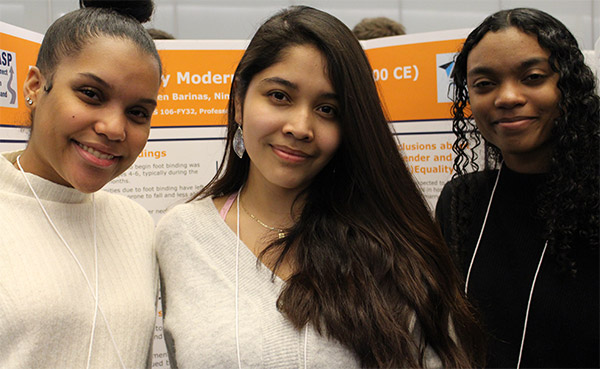
Barinas: We decided to focus on what cultural beliefs can do to the economic development of women in early modern China, specifically pertaining to foot binding. The practice of foot binding was primarily used between the 12th and 19th century. It was originally used by the royal court, but then it spread throughout the general population. It’s the restriction of the normal growth of feet, by breaking from the second to the fifth toe, and shaping the foot into what looks like a lotus flower. And, this practice was typically started as early as four years old because at that age feet are more malleable. In Chinese culture at that time, foot binding was a symbol of beauty and of the ability to marry into a wealthy family. But through our research we realized that foot binding prevented women from being independent. They couldn’t walk and because of this, they were dependent on men, which tied into their belief that women should stay home and be obedient to her husband. Our goal is to use our research to help others use their voice to advocate for gender equality and make sure that regardless of your identity, your opinions are being heard.
More scenes from the event:
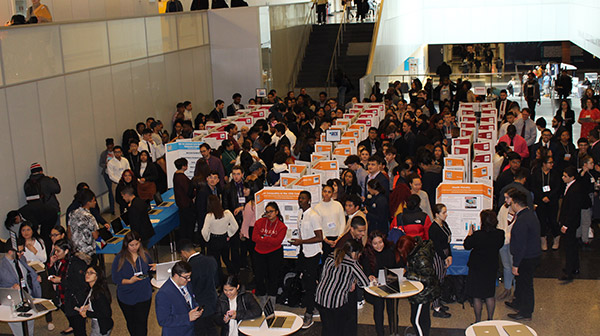
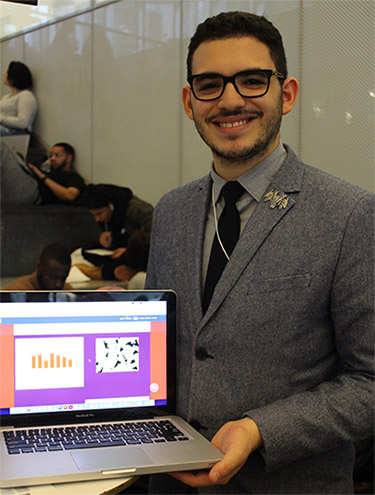
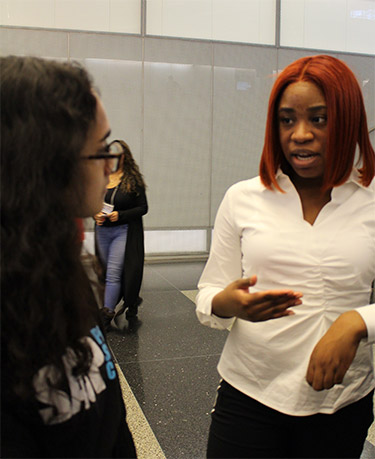
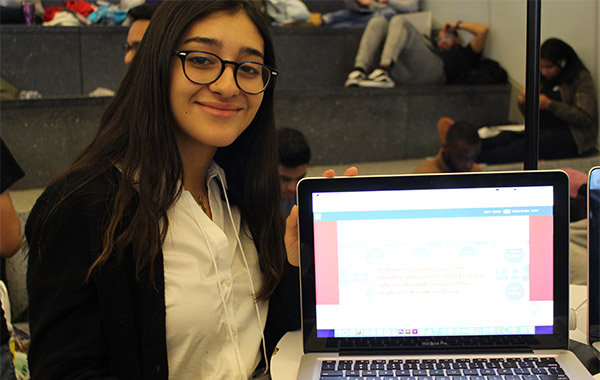
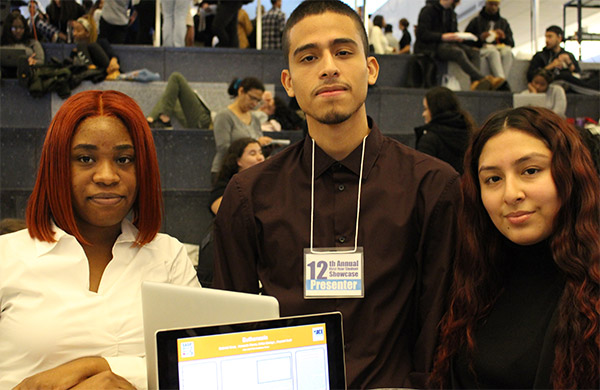
Learn more about some first-year student projects:



